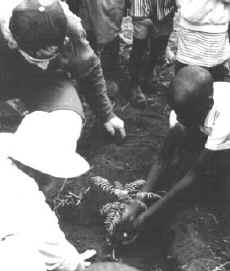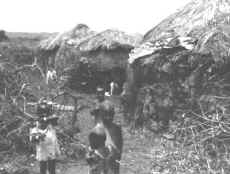Sharing the joys in the moment of giving
|
|



Julie and Ryan assist a young Maasai boy plant trees, our gift to
the village
 | We wanted to leave a legacy for the villagers as an expression of
gratitude for their hospitality.
|

 Connecting
with the children Connecting
with the children
Bruce Epis
I was filled with anticipation on the morning of our stay with the Maasai. After a
breakfast of bread and tea, we visited the Maasai school. Barnabas, the head master, had
started the school three years earlier. At first, he held class under a tree with only a
few students and one textbook, which they had to share. Now, there are two wooden
buildings, housing grades one through four.
I was struck by the beauty of the children and their bright smiles. They ranged in age
from five to nine; they seemed intimidated by my height. They welcomed me by shaking my
large hand with their tiny ones.
We worked with the small children to help them plant the trees that we had brought to
their village. I helped dig a hole and then watched as a young boy carefully placed a
drought-resistant jacaranda in the hole and covered it with soil. Then another child
watered the saplings. Some of our students began singing Kenyan songs with the children in
a circle around the trees. When my planting was done, I joined them.
It was a powerful and inspirational experience to see the singing children with
snow-capped Mt. Kilimanjaro in the background. I breathed in the fresh, clear air. As I
reflected on what we were doing, I realized that the trees that I had helped plant would
remain and grow with the children and the school, long after our group had left.
 Sowing
seeds of friendship Sowing
seeds of friendship
Gary Bacon
Maasai men, women, and children adorned in bright red, white, and blue clothing and
jewelry came from their distant clusters of bomas to greet us. They came to welcome us
with traditional songs and dances. They were preparing for the ceremony during which they
would present gifts to each of our little band of twenty-four people.
We, too, were ready to join in the festivities with our own songs, dances, and gifts.
We had brought two hundred bottles of orange and lemon sodas for the children. We had also
brought mabati for roofing and paper trees to plant around the newly constructed school
buildings.
The young Maasai children gathered about their older counterparts from the U.S. to
begin the tree planting. Age and cultures blended in a swirl of activity; we broke the
small saplings from the cardboard containers; we dug holes in the soft, rich earth, and we
placed the young trees gently into their new home. While two students covered the roots
with soil, another poured water from a big yellow bucket onto the freshly planted trees.
In a show of spontaneous celebration, Dana, Katy, and Rebecca joined hands and circled
a newly planted tree. They began to chant harmoniously as they looked downward on what
would someday be a shade tree for some yet unborn student of the Elangata-Enkima Primary
School. This inspired a flurry of larger circles of students, young and old, who wished to
celebrate the planting of these tiny trees.
Songs and chants of global music began to spring up around the small, newly
constructed wooden school building. The strong voice of a seven year old girl pierced the
air with song in her tribal tongue. This summoned a melodic response from all her
classmates, resulting in a beautiful call and response tribute to the human spirit.
I moved about, feebly attempting to capture a piece of this magic in my
|
|
camera's eye. Years of teaching and experience and
inculturation and activity fell away. I was left only with the moment—naked and
innocent and pure. Gone was my reference of past and future, and gone was my sense of I.
What remained was the moment, unfiltered by comparison, contrast, or relativity.
Tears gushed from my eyes. The view through the camera lens blurred in a salten sea of
bliss. All the students, black and white, and all the images of mountains and plains
pooled into one. Life had achieved union in a sea of universal harmony.
 Touring
the bomas Touring
the bomas
Jonathan Tourzan
After we had planted the trees, our group was given a tour of the surrounding bomas
and farms. We began by walking through a nearby boma. A boma refers to a hut or a circular
compound of huts surrounded by kojo kidogos (prickly thornbushes or
“wait-a-bits”). Kojo kidogos earned their unusual name by causing passer-bys who
walked into them to wait-a-bit to get unhooked from their spiky branches. The Maasai use
kojo kidogos to keep out lions during the night. If the lions are not kept out, they could
have a feast of beef and goat, as the Maasai keep these beasts inside the bomas in the
evening.
A mama (Maasai mother) showed me the inside of one mud hut. The huts seemed larger
inside than they looked from the outside. They had a kitchen, a meeting room for guests, a
bedroom, and a small room for keeping baby goats at night. The boma had about six huts,
each inhabited by a different family in the community. The ingenuity of the whole
organization of the bomas amazed me. They were constructed of mud, dung, and straw, yet
they seemed to provide sturdy and comfortable, even pleasant, living quarters.
After seeing the bomas, we went out to the shamba (farms). We saw crops, such as
maize, spinach, tomatoes, and cabbage. Traditionally the Maasai are nomadic
herdsmen—the formation of game parks and the emphasis on agricultural development
have restricted their movement, forcing some of them to settle down into one region.
Finally, we walked down to the stream. This small stream brought irrigation to the region,
making it ideal for human settlement.
During our tour, the school children walked with us. They would come up to me and
inquisitively look into my eyes. When I gave one of them my hand, he smiled contentedly.
We walked hand-in-hand to the stream. I was touched by the innocence of these children who
had never seen the greed and cruelty of our Western world. Their world seemed to end at
that stream and go no farther. After the tour, I went back to my tent where I played a
raga on my flute for my little friends. This music was completely new to them, and they
listened in awe. I felt good sharing this small part of myself with the beautiful
children.
 Entering
the boma Entering
the boma
Vanessa Tubbs
A little boy grabbed my hand and led me to the entrance of a boma. Kojo kidogos
surrounded the small compound to keep wild animals out. A circle of about six huts
surrounded a six inch sea of fresh cow dung. Children ran around barefoot, ignoring the
millions of flies. I wanted to take off my shoes and feel the dung squish between my toes.



One little boy yanked my hand, leading me to a hut. I had to duck down to fit inside.
It was so dark that I couldn't see in front of me, but I could smell the wood from a
burning fire. I worked my way through a maze-like passage to the main room. From the
sunlight that crept through the cracks, I noticed two small rooms with bedding on the
ground. Then I noticed a woman sitting by the fire, and she spoke to me in Maasai. I
couldn't understand her, so I went to her and shook her hand. I greeted her in Maasai,
“Sopa!” (Hello!). Then the boy tugged at my hand and led me out; I didn't want
to go; I wanted to stay and learn more about this simple, yet wonderful way of life.
|